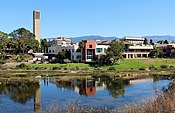 Elings Hall which houses The AlloSphere, August 2013 | |
| Established | 2007 |
|---|---|
Field of research | Technology, multimedia, sciences, art, design |
| Director | JoAnn Kuchera-Morin |
| Location | Santa Barbara, California, United States |
| Campus | University of California, Santa Barbara |
| Website | http://www.allosphere.ucsb.edu/ |
The AlloSphere is a research facility in a theatre-like pavilion in a spherical shape, of opaque material, used to project computer-generated imagery and sounds. Included are GIS, scientific, artistic, and other information. [1] Located at the University of California, Santa Barbara (UCSB) the AlloSphere grew out of the schools of electrical engineering and computer science, and the Media Arts & Technology program at UCSB. [2]
Contents
The AlloSphere is housed at UCSB California NanoSystems Institute [3] building, "CNSI," or Elings Hall, a 62,000-square-foot (5,800 m2) facility that opened in 2007. [4] The AlloSphere is intended to integrate technology and media. [5]
The AlloSphere includes a three-story cube that has been insulated extensively with sound-absorbing material, making it one of the largest echo-less chambers in the world. Within the chamber are two hemispheres of 5 meter radii, made of perforated aluminum. These are opaque and acoustically transparent. [6]
There are 26 video projectors, to create as much of a field of vision as possible. [6]
The loudspeaker real-time sound synthesis cluster (140 individual speaker elements plus sub-woofers) is suspended behind the aluminum screen resulting in 3-D audio. Computation clusters include simulation, sensor-array processing, real-time video processing for motion-capture and visual computing, render-farm/real-time ray-tracing and radiosity cluster, and content and prototyping environments. [6]
The AlloSphere was developed by a team of scientists, led primarily by Professor JoAnn Kuchera-Morin, a professor in the field of Composition, of the Media Arts & Technology Program of UCSB. [6]
